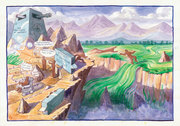
Csikszentmihalyi developed a 'systems' model for creativity which contains three components. The first of these is the domain, which consists of a set of symbolic rules and procedures. The second component of creativity is the field, which includes all the individuals who contribute to the field who act as the gatekeepers to the domain. They decide whether a new idea or product can be accepted. These people decide what new contributions are relevant and what should be recognised, preserved and remembered. The third component is the individual, who using symbols of a given domain, comes up with a new idea or sees a new pattern or contributes a performance that adds value to the field. It is the thoughts and actions of individuals or co-creating groups of people whose thoughts or actions change a domain, or establish a new domain.
My own research into higher education practices aligns with this well established conceptual framework but how does it relate to my own learning ecology. The domain I am contributing my thinking and writing too is the domain of education/higher education and the field I am trying to influence is the field of educational practice - particularly people who have a developmental role within universities (educational, professional, curriculum, student development and organisational development). Looking back I can see that I have tried to engage with and influence the field of practitioners in four ways.
Firstly, I tried to grow the knowledge from the field itself by involving practitioners in the study. It is their knowledge and perspectives that provide the new and original contribution
in the e-book. The act of feeding back the views of other members of the field and inviting comment was a way of testing whether the products have value to the field and ultimately the domain. I did not receive any negative feedback and the positive feedback gave me confidence that what I had produced was of value.
Secondly, I tried to engage other practitioners through an on-line survey. While very few members of the field accepted the invitation to complete the survey the notice was circulated by email to many hundreds of practitioners on the specialist mail lists or postings in on-line special interest groups. The small numbers of respondents might suggest that what I was doing was of no interest to them or it might indicate that culturally most practitioners do not get involved in on-line surveys.
Thirdly, thanks to two invitations to speak on the subject of creativity in higher education I will be able to present and discuss my ideas at two conferences in November.
Fourthly, my consolidated learning has been made explicit in an e-book which provides me with the vehicle for recording my contribution to the domain and I will publish it on a website under a creative commons license so that practitioners can access it with no financial cost to themselves. This means that the ideas will be publicly accessible in a global sense.
Finally, when the work is complete I will make it freely available and disseminate information about its availability to the field via email networks. In this way I anticipate that those who are interested and willing to spend the time reading, will access my ideas and take from them those aspects that they find useful and meaningful.
Only time will tell whether the ideas contained in my e-book will be seen by the domain as being relevant and significant enough to warrant citation and adoption by practitioners in the field. By putting a stat counter on the web page I can monitor how many people access it so that will give me an indication of the interest in the field. If further invitations to speak arise from this work that will be another indication that the ideas have value to people who are practising in the field.
But there is another very important dimension to the field and that is the way people in the field contribute to the creative work. In my learning ecology two people stand out in the extent to which they contributed materially to the creative product through the insightful feedback they provided, the way they challenged ideas or perspectives, and the encouragement they gave me to persist. In the world of sharing and shaping academic ideas it is the unseen hand of collegiality that shapes the creative work and makes it more acceptable to the field.
Csikszentmihalyi's cultural domain-field model has much relevance to my learning ecology and the creative work that emerged from the ecological process.




 RSS Feed
RSS Feed